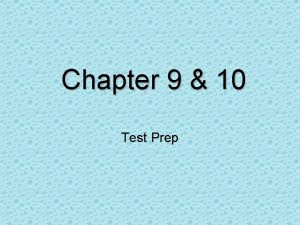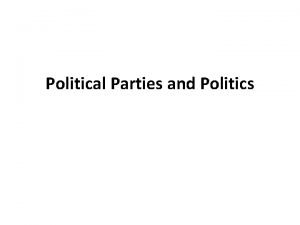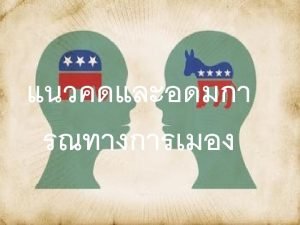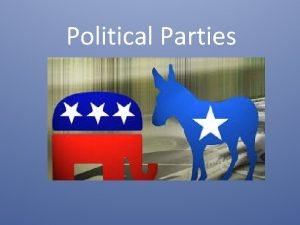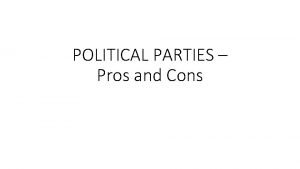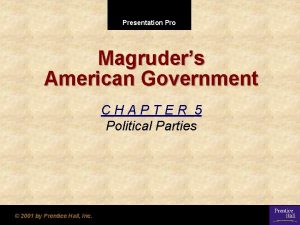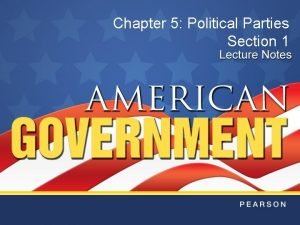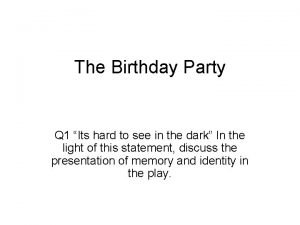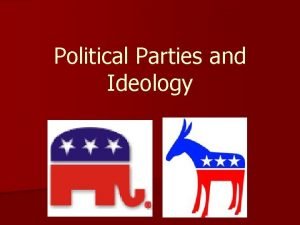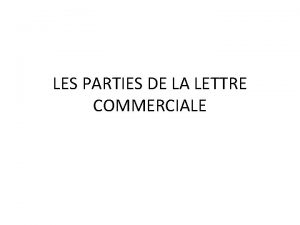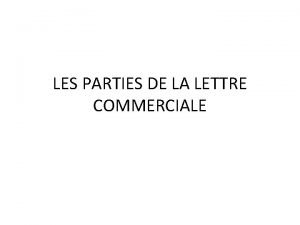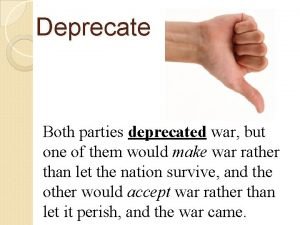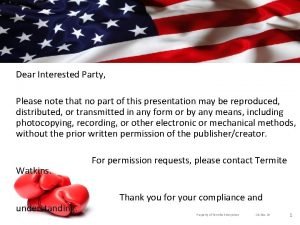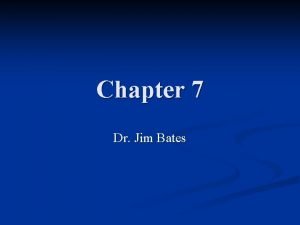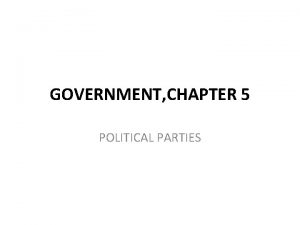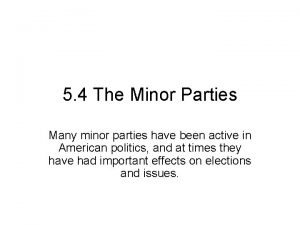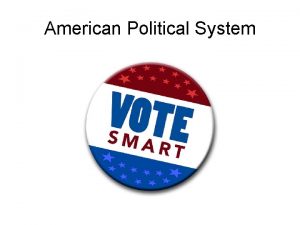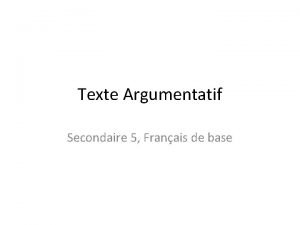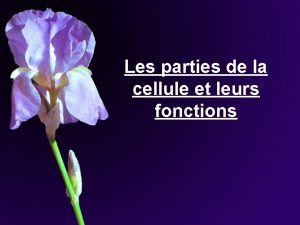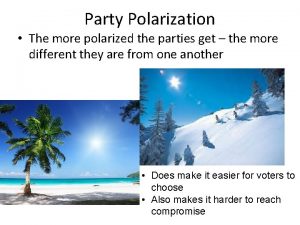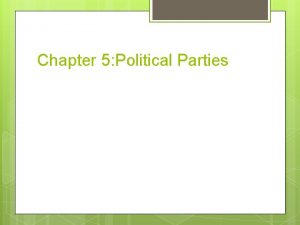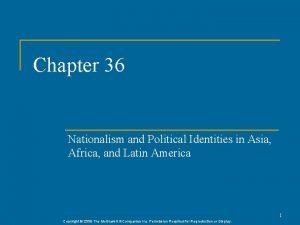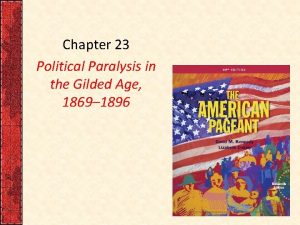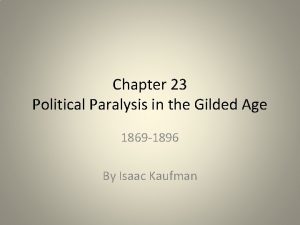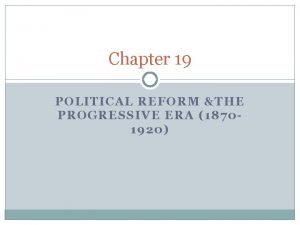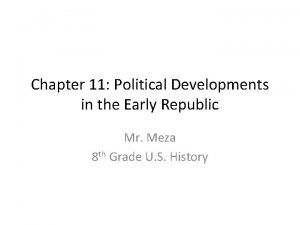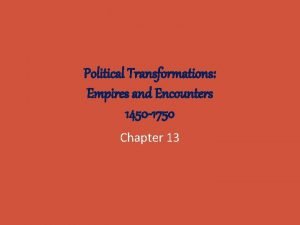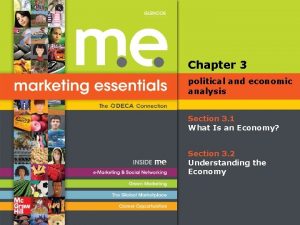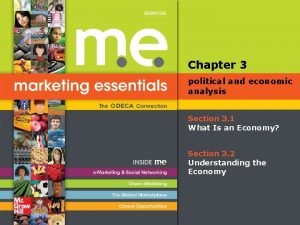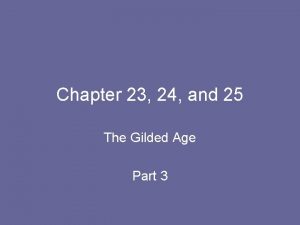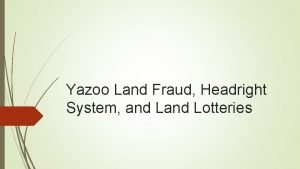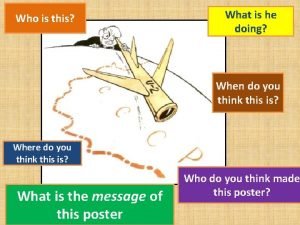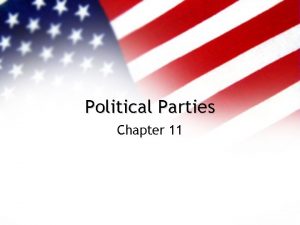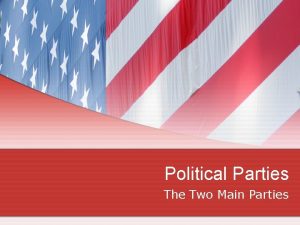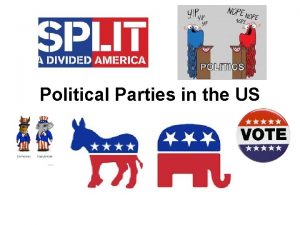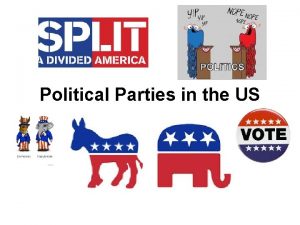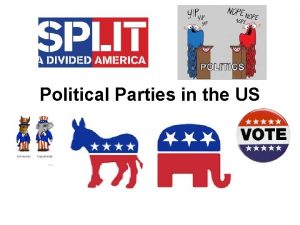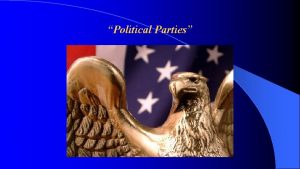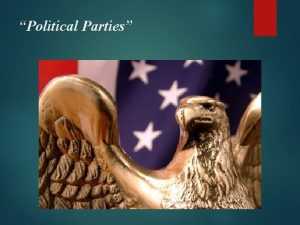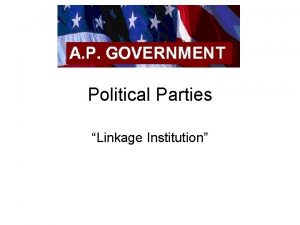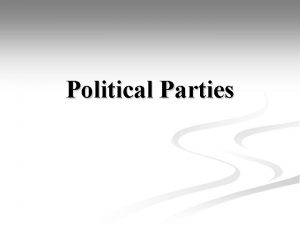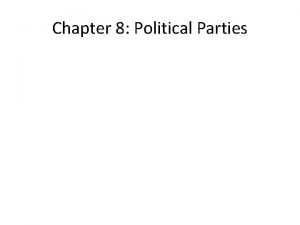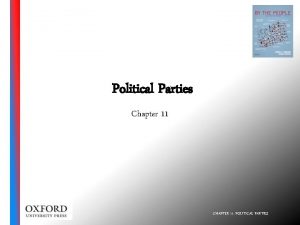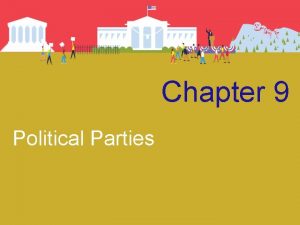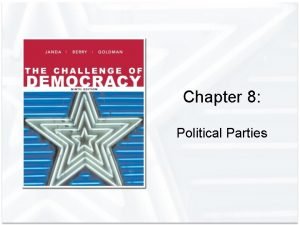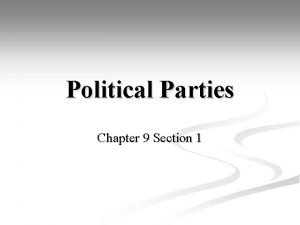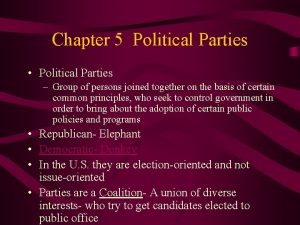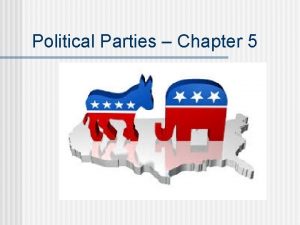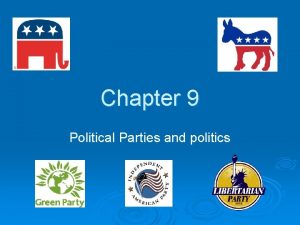Political Parties Chapter 12 Political Parties What is

















































- Slides: 49

Political Parties Chapter 12

Political Parties What is a Political Party? Roles/Functions of American Parties Basic Structure of American Political Parties Party in Government Modern Transformation of Party Organization Party in Electorate One-Partyism and Third-Partyism

What is a Political Party? A group of voters, activists, candidates, and office holders who identify with a party label and seek to elect individuals to public office Interest Group - narrower, public policy

Political Parties Organized effort to gain power through elections Consist of three entities Governmental Party, or office holders Organizational Party, or the workers and activists Party in the electorate, or the voters


Roots of the Two-Party System The Golden Age, 1860 -1932 Lincoln, Republicans Political Machines Tammany Hall The Modern Era New Deal Candidate Centered Politics Citizen Support an Party Realignment Critical Elections

Functions of the Party System Mobilizing support and building coalitions Encouraging stability in the political system Providing accountability for public policy Running candidates for office Providing a cue for voters Formulating policy through a national party platform

Parties organize the election process Parties represent group interests Parties simplify political choices Parties organize government and policy making

Activities of American Political Parties Organizing government Parties in Congress Loyalty The Party Line Decentralization The presidential party Parties in the federal courts

Political Parties and Democracy Political Parties are organizations that exist to allow like-minded members of the population to group together and magnify their voices into a focus promoting individual candidates and government action

Party Organization Parties at the Grassroots Local party organizations provide for people seeking involvement in politics State party organizations organize elections, provide electoral college votes needed to win presidency Committee leaders supervise functions of state parties State parties work with state governments to conduct primary elections Party structure varies state to state Machine politics - trading jobs for political support

Basic Structure of American Political Parties The organizational structure of America’s political parties remains fairly simple with aspects of national, state, and local influence: National Committees/Conventions State Central Committees Local City/Precinct Committees Informal Groups: Think Tanks and Reform Groups


National Party Organization Visible mostly around presidential elections Party Platform - official statement of principles and policies

Modern Transformation of Party Organization Republican Party Strengths: Party Staff - several hundred operatives stationed in key districts Voter Contact - telephone canvassing and bulk mailings Polling Media Advertising - in-house media division Staff Training and Research



Party in Government Parties play a major role in organizing Congress Parties shape perceptions of presidents Presidents---to varying degrees---act as party leaders Party may predict some judicial decisions

Congressional Party Parties select party leaders and make committee appointments Organize and operate Congress Web of deputy and assistant whips Majority party generally holds more power Party discipline Hurt by individualistic nature of US politics But party voting has increased since the 1970 s


The Presidential Party of the President Captures the public imagination Shapes the electorate’s opinion of the two parties Perceptions of the incumbent president and the presidential determine how citizen’s perceive the parties Some presidents more party-oriented George W. Bush considered pro-party Eisenhower “non-partisan” president - hurt his party

Parties and the Judiciary Viewed as “above-politics” and nonpartisan judges are products of their party identification Presidents choose judicial candidates from the ranks of their party Many have had long careers as loyal party workers or legislators

Party in the Electorate The “party in the electorate” is the mass of potential voters who identify with a specific party American voters often identify with a specific party, but rarely belong formally Party identification is often a voter’s central political reference symbol Party identification generally comes from one’s parents However, party identification can be affected by a number of factors such as education, peers, charismatic personalities, cataclysmic events, and intense social issues

Party Identification shapes political worldview May be shaped by demographic characteristics South, middle-aged, and white-collar more Republican Evangelicals and married more Republican Women, minorities, and Jews more Democratic Unions, advanced degrees, and single more Democratic




Loyalty Trends - Democratic Labor Union members tend to vote Democratic Democrats have a lead in garnering the women’s vote Over 80% of African Americans and Hispanics vote Democratic Young people are more Democratic Most blue-collar workers and unemployed are Democrats Catholics and Jews are mostly Democrats The widowed are mostly Democrats Liberals tend to be Democrats

Loyalty Trends - Republican Chamber of Commerce members tend to vote Republican The West tends to be more Republican Men tend to split fairly evenly between the two parties Cuban-Americans are generally Republicans (anti-Castro) Professionals, executives, and white-collar workers tend to be Republican High-status Protestants tend to be Republican Married couples tend to be Republican Conservatives tend to be Republican




Declining Party Loyalty? The number of independents in the US rose from 19% in 1957 to 37% in 1980 Identification with the two major parties today is in the mid 70 -80% Pollsters often find that many self-declared independents often “lean” quite strongly to either the Democratic or Republican party “Leaners” do feel party affiliations, but choose not to self-identify with a party

Party Realignment During a realignment, party coalitions change Critical elections put key issues into perspective 1800, 1860, and 1932 were critical elections No uniform realignment has occurred since 1932 Political system characterized by secular realignment

Party Realignment A shifting of party coalition groupings in the electorate that remains in place for several elections Critical election an election that signals a party realignment through voter polarization around new issues Secular Realignment the gradual rearrangement of party coalitions, based more on demographic shifts than on shocks to the political system


Dealignment and Party Stength Argument that we are in a period of dealignment Voters are much less likely to identify with a party Result of the growth of issue-oriented politics Parties are important in electorate an in government Parties continue to be competitive with one another

One-Partyism and Third-Partyism A significant trend of recent times is the demise of onepartyism (one-party dominance of elections in a given region) The formerly “Solid South” is no longer only Democratic There are no exclusively Republican or Democratic states at this time Many individuals split their vote between the parties, and sometimes vote for third parties

Minor Parties in the American Two. Party System Formation and role of the third party Social issues Civil Rights issues Trust in government Effectiveness Barriers to third-party success

Minor Parties Winner-take-all system makes it difficult to win office Sharp contrast to proportional systems used elsewhere Rooted in sectionalism, protest, issues, and people Do best when there is little trust in other parties Can have success in putting issues on agenda

Third-Partyism Minor parties are not a threat to the two major parties Only eight third parties have won any electoral votes in a presidential election Third Parties that have had some success 1996 and 1992: Ross Perot’s Reform Party 1968: George Wallace’s American Independent Party 1924: Robert La. Follette”s Progressive Party 1912: Teddy Roosevelt’s Bull Moose Party 1856: Millard Fillmore’s American Party

Modern Third Parties in US Libertarian Party Green Party Reform Party Tea Party

Ideological Parties Ideological Party Third party that exists to promote an ideology rather than to win elections Socialist Party is an example. Have run a candidate in presidential election for past 100 years

Protest Parties Third party that arises in response to issues of popular concern which have not been addressed by the major parties

Single-Issue Parties Third party formed around one particular cause Prohibition Party Green Party

Barriers to Minor-Party Success Institutional Barriers Single-Member districts Electoral College Ballot Access Laws Attitude Barriers Wasted Vote Syndrome

Why does the Two-Party System Persist? There is little support in the American political culture for avowedly fascist, communist, authoritarian, or other antidemocratic parties Cultural Consensus

Is the Party Over or has it Just Begun? Parties’ decline can easily be exaggerated - why? Usually have been reliable vehicles for mass participation Both major parties have demonstrated flexibility and pragmatism, which has helped ensure their survival and the success of the society they server Have continued to provide competition for each other and hte voters at the national level Party in government and the party organizations are stronger than ever, regardless of the fluctuations found in party in the electorate

Websites Major Parties Democratic National Committee www. democrats. org Republican National Committee www. rnc. org Third Parties Third Party Central
 Brainpop presidential election
Brainpop presidential election What was one way progressives differed from populists
What was one way progressives differed from populists Political parties
Political parties The supreme court change
The supreme court change Political parties
Political parties Soup and ideology
Soup and ideology Political parties
Political parties Political parties pros and cons
Political parties pros and cons Economic protest parties definition
Economic protest parties definition Chapter 5 section 1 parties and what they do
Chapter 5 section 1 parties and what they do Chapter 5 section 1 parties and what they do
Chapter 5 section 1 parties and what they do Birthday party analysis
Birthday party analysis Define ideological parties
Define ideological parties Contoh masakan pesta adalah
Contoh masakan pesta adalah Les différentes parties de la lettre commerciale
Les différentes parties de la lettre commerciale La lettre commerciale
La lettre commerciale Les parties du corps du dauphin
Les parties du corps du dauphin Objective of quality
Objective of quality Deprecate in a sentence
Deprecate in a sentence Dear interested parties
Dear interested parties Les différentes parties d'un microscope optique
Les différentes parties d'un microscope optique Why does gatsby stop giving parties?
Why does gatsby stop giving parties? Economic protest parties definition
Economic protest parties definition Sarah and pam often go to parties
Sarah and pam often go to parties Plan de texte narratif
Plan de texte narratif Accounting information system chapter 1
Accounting information system chapter 1 Economic protest parties
Economic protest parties Socialist parties
Socialist parties Texte argumentatif plan simple
Texte argumentatif plan simple Articulatio incudostapedialis
Articulatio incudostapedialis Comparaison entre cellule animale et végétale
Comparaison entre cellule animale et végétale Why is gatsby's love for daisy doomed to fail
Why is gatsby's love for daisy doomed to fail Power point parties
Power point parties Horses hate surprise parties
Horses hate surprise parties What does the graph indicate?
What does the graph indicate? Gaines techniques parties communes
Gaines techniques parties communes Splinter parties definition
Splinter parties definition Chapter 35 nationalism and political identities in asia
Chapter 35 nationalism and political identities in asia Chapter 36 nationalism and political identities in asia
Chapter 36 nationalism and political identities in asia Chapter 23 political paralysis in the gilded age
Chapter 23 political paralysis in the gilded age Political paralysis in the gilded age
Political paralysis in the gilded age Chapter 19 political reform and the progressive era
Chapter 19 political reform and the progressive era Political developments in the early republic
Political developments in the early republic Chapter 5 political transformations empires and encounters
Chapter 5 political transformations empires and encounters Chapter 3 political and economic analysis
Chapter 3 political and economic analysis Chapter 3 political and economic analysis
Chapter 3 political and economic analysis Chapter 23 political paralysis in the gilded age
Chapter 23 political paralysis in the gilded age Define headright system
Define headright system Umass lowell political science
Umass lowell political science U2 crisis cartoon
U2 crisis cartoon

